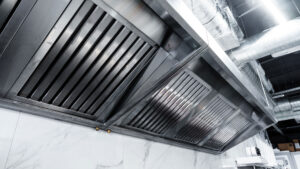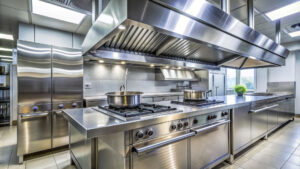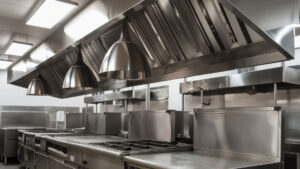Think of your commercial kitchen hood as the lungs of your restaurant. Just as our lungs filter the air we breathe, your kitchen hood system works tirelessly to remove smoke, grease, and airborne contaminants from your cooking space. And just like our lungs need regular care to function properly, your hood system requires thorough, professional cleaning to keep your kitchen safe and efficient.
Understanding Your Kitchen Hood System
Before diving into cleaning specifics, let’s understand what makes up your hood system. The typical commercial kitchen hood consists of several crucial components working in harmony:
The visible hood canopy that hangs above your cooking equipment serves as the first line of defense, capturing rising smoke and grease-laden vapors. Within this hood, you’ll find the grease filters – those metal baffles that trap larger grease particles before they can enter the ductwork. Behind these visible components lies an intricate network of ductwork that carries contaminated air up through the building and out to the exterior, powered by an exhaust fan typically mounted on the roof.
The Science of Grease Accumulation
When you’re cooking, especially with high-heat methods like frying or grilling, tiny grease particles become airborne. As these particles travel up through your hood system, they begin to cool and condense, sticking to the surfaces they encounter. Over time, this process creates a dangerous accumulation of grease that can fuel a potential fire.
The Professional Cleaning Process
A proper hood cleaning involves several careful steps, each crucial for maintaining safety and efficiency:
Initial Assessment
Professional cleaners begin by inspecting your entire system, from the hood canopy to the exhaust fan. They’re looking for the extent of grease buildup and any potential issues that need addressing. This inspection helps determine the cleaning approach needed for your specific situation.
Filter Removal and Cleaning
The first hands-on step involves removing all grease filters. These filters are typically soaked in a specialized degreasing solution and cleaned thoroughly until they reach bare metal. Many restaurants maintain multiple sets of filters to swap out during cleaning, ensuring continuous operation.
Hood Cleaning
The hood canopy receives special attention, as it’s often the most visibly greasy component. Technicians apply degreasing agents and use scrapers and hot water to remove accumulated grease. Every surface inside the hood must be cleaned to bare metal – a standard that ensures proper function and fire safety.
Ductwork Maintenance
Perhaps the most critical yet often overlooked aspect is ductwork cleaning. Professional cleaners access the duct system through specific access panels, using specialized tools to remove grease buildup throughout the entire length of the ductwork. This process might require multiple access points to ensure thorough cleaning of horizontal runs and direction changes.
Fan Cleaning
The exhaust fan, typically mounted on the roof, requires careful attention. Both the fan blades and housing must be thoroughly cleaned, as grease buildup here can affect the fan’s efficiency and create fire hazards. Technicians also inspect the fan’s operation and belt tension during this process.
The Impact of Regular Cleaning
Maintaining a clean hood system delivers several crucial benefits:
Fire Prevention: Clean systems dramatically reduce the risk of grease fires, protecting your investment and ensuring safety.
Energy Efficiency: A clean system operates more efficiently, reducing energy costs and extending equipment life.
Code Compliance: Regular cleaning helps maintain compliance with health and fire safety regulations, avoiding costly violations.
Air Quality: Clean hood systems improve kitchen air quality, creating a better working environment for your staff.
Creating a Maintenance Schedule
The frequency of professional hood cleaning depends on your cooking volume and methods:
Monthly cleaning is essential for solid fuel cooking operations or extremely high-volume kitchens.
Quarterly cleaning suits most high-volume operations using standard cooking methods.
Semi-annual cleaning might suffice for moderate-volume operations.
Annual cleaning is the minimum requirement for low-volume operations.
Between Professional Cleanings
While professional cleaning is crucial, daily maintenance practices help maintain system efficiency:
Train staff to clean hood surfaces and filters regularly
Monitor grease accumulation in visible areas
Keep detailed cleaning records
Report any changes in system performance immediately
Looking Beyond Basic Cleaning
Modern hood systems might include additional components that require special attention during cleaning:
UV Systems: Some hoods include ultraviolet light systems for grease breakdown
Pollution Control Units: These additional filtering systems need separate cleaning protocols
Fire Suppression Systems: These must be properly covered during cleaning and inspected afterward
Making the Investment
Professional hood cleaning might seem expensive, but consider it an investment in your business’s safety and longevity. The cost of proper maintenance pales in comparison to the potential losses from a grease fire or health code violations.
When selecting a hood cleaning service, look for:
– Proper certification and insurance
– Detailed documentation practices
– Modern cleaning equipment and techniques
– Thorough inspection processes
– Emergency service availability
Remember, your kitchen hood system plays a vital role in your operation’s safety and efficiency. Investing in proper cleaning and maintenance protects your business, your employees, and your customers while ensuring your kitchen runs at peak performance.
Need help developing a cleaning schedule for your kitchen hood system? Contact us today so we can work with you to create a compliant cleaning schedule!



